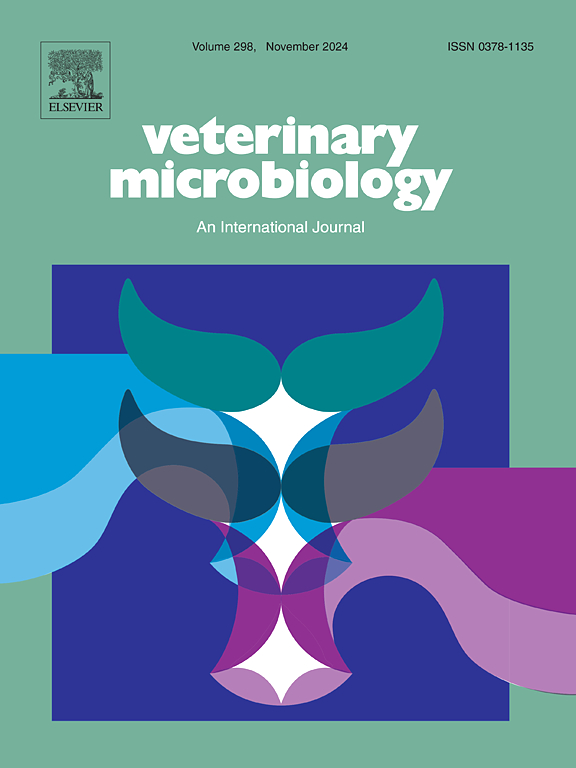禽戊型肝炎引发蛋类下降:病毒-宿主、免疫-神经内分泌机制
IF 2.7
2区 农林科学
Q3 MICROBIOLOGY
引用次数: 0
摘要
戊型肝炎病毒(aHEV)是肝炎病毒科的一员,对家禽的健康和生产力构成重大威胁,特别是对蛋鸡的产蛋量产生有害影响。这篇综述阐明了ahev诱导蛋鸡产蛋量下降的多方面机制,重点是病毒与宿主的直接相互作用、免疫失调和神经内分泌干扰。aHEV对生殖器官表现出强烈的亲和性,在卵巢组织中活跃的复制导致卵泡凋亡、结构损伤和激素失衡。病毒蛋白(ORF1-ORF3)通过免疫逃避、氧化应激诱导和钙代谢破坏驱动发病机制。值得注意的是,orf2介导的宿主受体结合和orf2介导的病毒输出协同损害卵巢功能,而基因型特异性变异(如gt3/gt5)影响组织特异性和致病性。全身炎症和下丘脑-垂体-性腺(HPG)和下丘脑-垂体-肾上腺(HPA)轴失调通过改变促性腺激素信号和雌激素合成进一步加剧生殖功能障碍。尽管诊断技术(如基于orf2的抗原检测)有所进步,疫苗开发有限(如中国的Hecolin®),但针对多种aHEV基因型的交叉保护仍然不足。具有增强毒力(如SDXT20)和重组潜力的新出现菌株突出了对基因型跨越干预的迫切需要。我们提出抗氧化疗法、受体阻断策略和针对保守ORF2/ORF3区域的多表位疫苗可以减轻aHEV的经济影响。此外,关于病毒潜伏期、经卵巢传播和人畜共患风险等尚未解决的问题需要结合类器官模型、单细胞组学和One Health监测的综合方法来解决这一不断变化的挑战。本文章由计算机程序翻译,如有差异,请以英文原文为准。
Avian HEV triggered egg decline: Viral-host, immune-neuroendocrine mechanisms in layers
Avian hepatitis E virus (aHEV), a member of the Hepeviridae family, poses substantial threats to poultry health and productivity, particularly through its detrimental impact on egg production in laying hens. This review elucidates the multifaceted mechanisms underlying aHEV-induced egg production decline in laying hens, focusing on direct viral-host interactions, immune dysregulation, and neuroendocrine disruption. aHEV exhibits strong tropism for reproductive organs, with active replication in ovarian tissues causing follicular apoptosis, structural damage, and hormonal imbalance. Viral proteins (ORF1-ORF3) drive pathogenesis through immune evasion, oxidative stress induction, and disruption of calcium metabolism. Notably, ORF2-mediated host receptor binding and ORF3-mediated viral egress synergistically impair ovarian function, while genotype-specific variations (e.g., gt3/gt5) influence tissue specificity and pathogenicity. Systemic inflammation and hypothalamic-pituitary-gonadal (HPG) and hypothalamic-pituitary-adrenal (HPA) axis dysregulation further exacerbate reproductive dysfunction by altering gonadotropin signaling and estrogen synthesis. Despite advances in diagnostics (e.g., ORF2-based antigen assays) and limited vaccine development (e.g., China’s Hecolin®), cross-protection against diverse aHEV genotypes remains inadequate. Emerging strains with enhanced virulence (e.g., SDXT20) and recombination potential highlight the urgent need for genotype-spanning interventions. We propose that antioxidant therapies, receptor-blocking strategies, and multi-epitope vaccines targeting conserved ORF2/ORF3 regions could mitigate aHEV’s economic impact. Furthermore, unresolved questions regarding viral latency, transovarial transmission, and zoonotic risks necessitate integrated approaches combining organoid models, single-cell omics, and One Health surveillance to address this evolving challenge.
求助全文
通过发布文献求助,成功后即可免费获取论文全文。
去求助
来源期刊

Veterinary microbiology
农林科学-兽医学
CiteScore
5.90
自引率
6.10%
发文量
221
审稿时长
52 days
期刊介绍:
Veterinary Microbiology is concerned with microbial (bacterial, fungal, viral) diseases of domesticated vertebrate animals (livestock, companion animals, fur-bearing animals, game, poultry, fish) that supply food, other useful products or companionship. In addition, Microbial diseases of wild animals living in captivity, or as members of the feral fauna will also be considered if the infections are of interest because of their interrelation with humans (zoonoses) and/or domestic animals. Studies of antimicrobial resistance are also included, provided that the results represent a substantial advance in knowledge. Authors are strongly encouraged to read - prior to submission - the Editorials (''Scope or cope'' and ''Scope or cope II'') published previously in the journal. The Editors reserve the right to suggest submission to another journal for those papers which they feel would be more appropriate for consideration by that journal.
Original research papers of high quality and novelty on aspects of control, host response, molecular biology, pathogenesis, prevention, and treatment of microbial diseases of animals are published. Papers dealing primarily with immunology, epidemiology, molecular biology and antiviral or microbial agents will only be considered if they demonstrate a clear impact on a disease. Papers focusing solely on diagnostic techniques (such as another PCR protocol or ELISA) will not be published - focus should be on a microorganism and not on a particular technique. Papers only reporting microbial sequences, transcriptomics data, or proteomics data will not be considered unless the results represent a substantial advance in knowledge.
Drug trial papers will be considered if they have general application or significance. Papers on the identification of microorganisms will also be considered, but detailed taxonomic studies do not fall within the scope of the journal. Case reports will not be published, unless they have general application or contain novel aspects. Papers of geographically limited interest, which repeat what had been established elsewhere will not be considered. The readership of the journal is global.
 求助内容:
求助内容: 应助结果提醒方式:
应助结果提醒方式:


